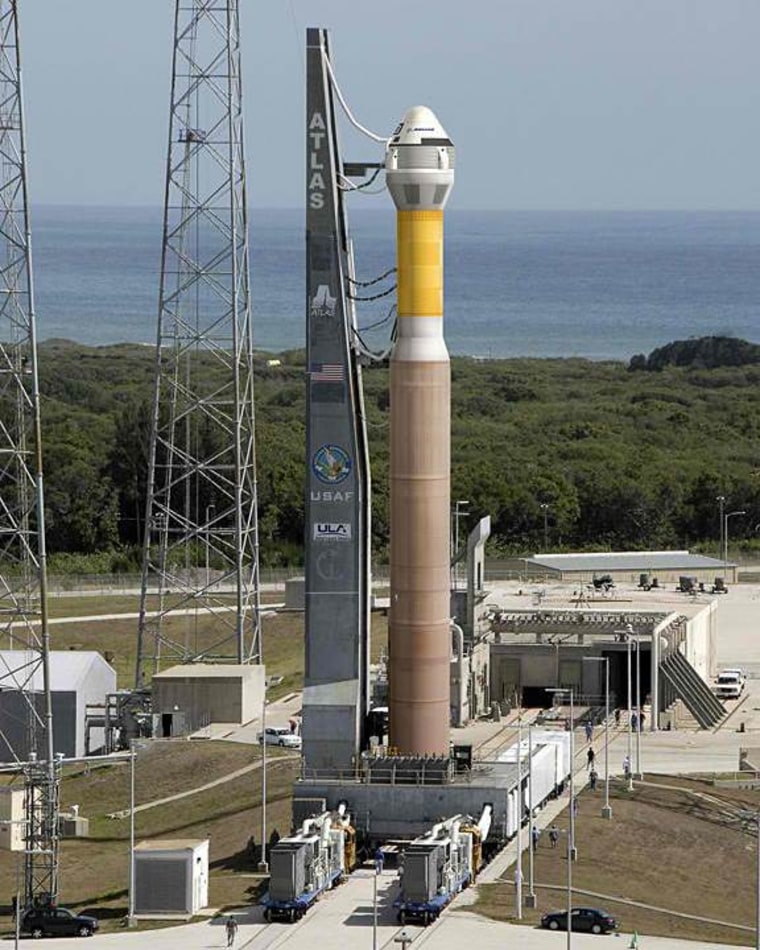Test flights of The Boeing Co.'s future crew-carrying spaceship would be conducted starting as early as 2015 on United Launch Alliance's Atlas 5 rocket, executives announced Thursday.
Whether Boeing's CST-100 capsule actually flies in that timeframe depends on whether NASA provides the necessary development funding, said John Elbon, the aerospace company's manager for the commercial crew project. But just in case, Boeing is already looking for pilots who could help with the design and testing of the craft.
"We've only just started the interview process for that," Elbon told reporters during a teleconference. The candidates for Boeing's astronaut corps could include former NASA astronauts as well as test pilots who have never flown in space before, he said.
He expected the first astronaut to be chosen in the next "half-year" or so.
Boeing is already receiving $92.3 million for NASA in the second phase of the space agency's commercial crew program, which is aimed at supporting the development of new private-sector U.S. spaceships for servicing the International Space Station now that the space shuttle fleet has been retired.
That money is going toward the design and initial ground testing for the CST-100, a conical capsule that could carry seven passengers to the International Space Station or other orbital destinations. Millions more are going to three other companies that are working on their own spaceships: Blue Origin, Sierra Nevada Corp. and SpaceX.
For the next phase of NASA's program, commercial providers will be expected to propose an integrated system, taking in all aspects of the orbital transportation from training to launch and mission operations. Blue Origin and Sierra Nevada have already said they intend to go with the Atlas 5, while SpaceX plans to use its own Falcon 9 rocket.
It took months for Boeing to decide which rocket it would use. Elbon said executives considered United Launch Alliance's offerings as well as alternatives from SpaceX and ATK. Elbon said the Atlas 5's reliability was "an important consideration" in the selection process. The Atlas 5 has had an unblemished record of success over 26 launches, and it's due to send NASA's Juno spacecraft toward Jupiter on Friday.
The selection process was slightly complicated because Boeing is one of the venture partners in United Launch Alliance, along with Lockheed Martin. The Federal Trade Commission had to review Boeing's decision to ensure that it wasn't biased, and Elbon said the FTC's notice of compliance was received late last month.
Boeing's craft would be launched from Cape Canaveral, Fla., on an Atlas configuration known as the 412, which includes a solid rocket booster and a dual-engine Centaur upper stage. That's different from the rocket that will be used for Juno and for NASA's Mars Science Laboratory, which is due for launch in November.
Last month, United Launch Alliance and NASA struck a deal to work together on making the Atlas 5 crew-worthy. George Sowers, ULA's vice president for development, said the main tasks on the to-do list are to develop an Emergency Detection System and figure out the system for getting astronauts on and off the launch pad.
Elbon said Boeing's development time frame called for the CST-100 to undergo a launch-pad abort test in 2014, an unmanned orbital flight test in the first quarter of 2015, an ascent abort test in the middle of 2015, and a test flight to the International Space Station with Boeing pilots aboard by the end of that year.
"This is the quickest way to close the gap and get crews flying again," Elbon said.
He said the first operational flight for NASA astronauts, with a NASA pilot at the controls, would come in the first quarter of 2016. Eventually, commercial ventures such as Bigelow Aerospace may use the CST-100 to carry private-sector astronauts to their own space stations.
"Depending on the customer, we (Boeing) will have a pilot or not," Elbon said.
He emphasized that the time frame was dependent on continued development funding from NASA. Without that support, Boeing couldn't make the business case for the CST-100 project, he said.
So how much will be needed? Elbon declined to name a figure, citing competitive concerns, but he noted that the Obama administration sought $850 million for commercial crew development in its budget request for fiscal year 2012. "I think those numbers are in the neighborhood of what it would take to make this program successful," he said.
It's not clear how that request will fare in the current budget-cutting environment, but the program got at least one vote of support on Thursday, from U.S. Sen. Bill Nelson, D-Fla.
"The winner of this competition will be America," Nelson said in a statement. “All of this is going to bring down the cost and make human spaceflight more affordable.”
Nelson noted that private-sector spaceflight was aimed at freeing up NASA to pursue more ambitious exploration beyond Earth orbit — with potential missions planned to near-Earth asteroids, the moon and Mars — and he urged the space agency to move forward with that plan as well.
